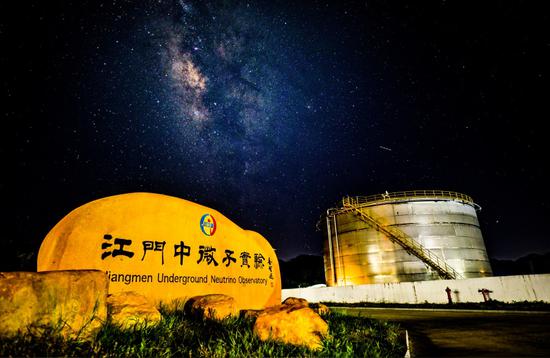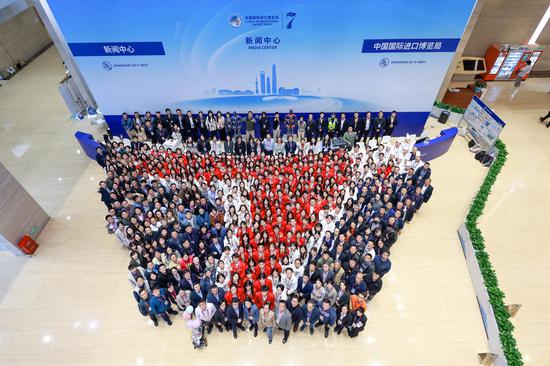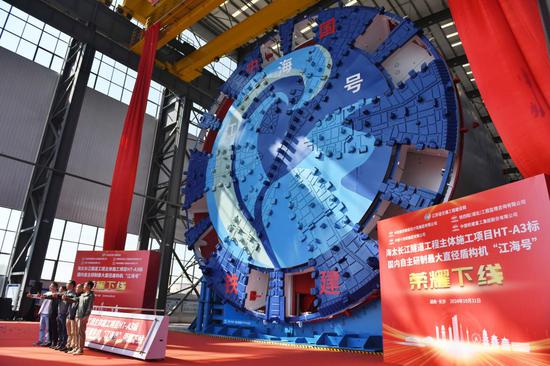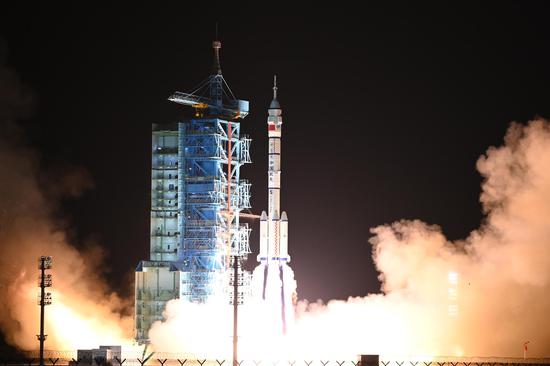
The construction of China's large scientific facility enters its final stage. (Photo provided to chinadaily.com.cn)
The construction of China's large scientific facility — the Jiangmen Underground Neutrino Experiment, has entered its final stage. It is expected that all installation will be finished by the end of this month.
Located 700 meters underground in Jiangmen, Guangdong province, a nearly 12-story-tall acrylic sphere is placed at the center of a 44-meter-deep water pool. This largest acrylic vessel in the world contains 20,000 tons of transparent liquid, which will play a crucial role in detecting neutrinos and exploring the origins of the universe.
"The primary scientific goal of the Jiangmen Underground Neutrino Observatory is to measure the neutrino mass hierarchy and oscillation parameters, which will play a crucial role in testing supernova explosion mechanisms, exploring the origins and evolution of the universe, and discovering new physical phenomena," said Wang Yifang, former director of the Institute of High Energy Physics at the Chinese Academy of Sciences.
Wang said that the birth of neutrinos is often related to extreme events in the universe, such as the Big Bang, supernova explosions, neutron star mergers, and black hole eruptions, with high-energy neutrinos mainly originating from collisions between cosmic rays and dust or gas.
Although neutrinos have existed since the early universe, it wasn't until 1930 that scientists proposed the hypothesis of their existence. It took another 26 years until physicists experimented with a nuclear reactor and detected the presence of neutrinos.
The mass of neutrinos remains a mystery to this day. Whether they are massless or have mass that directly impacts the evolution laws of the universe, scientists said.
"This construction of the new observatory will bring about significant breakthroughs in neutrino research," Wang said.
The 35.4-meter acrylic sphere is the crucial component of the core equipment of the Jiangmen Underground Neutrino Observatory — the central detector, surrounded by a stainless steel structure and filled with 20,000 tons of liquid scintillator.
"The main component of the liquid scintillator is alkylbenzene, a raw material used in everyday detergents such as laundry powder and hand soap, posing no harm to humans," said Cao Jun, current director of the institute.
When a large number of neutrinos pass through the detector, they react with the liquid scintillator, emitting extremely faint light that is invisible to the naked eye but serves as an important parameter for measuring neutrinos, he said.
The 45,000 "eyes" of the detector receive light signals, convert them into electrical signals, amplify them by a factor of 10 million, transmit them to a computer via an electronic system, and through data analysis, scientists can study the properties of neutrinos.
"Neutrino research belongs to fundamental research, helping us understand how the universe formed and evolved, what the laws governing our natural world are like, serving as the foundation for all possibilities. With these laws, we can gradually turn scientific discoveries into technologies, ultimately benefiting our lives," Cao said.
"In a few years, it may, like Newton's discovery of universal gravitation, Faraday's discovery of electromagnetic induction, and Planck's discovery of quantum energy, change the world," he said.


















































 京公网安备 11010202009201号
京公网安备 11010202009201号